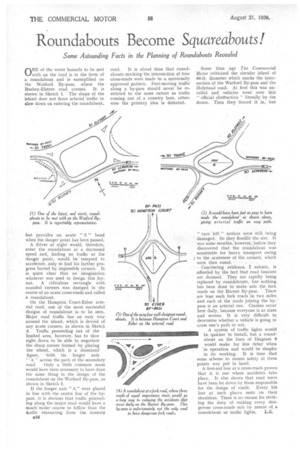Roundabouts Become Squareabouts I Some Astounding Facts in the Planning
Page 58

If you've noticed an error in this article please click here to report it so we can fix it.
of Roundabouts Revealed nNE of the worst hazards to be met V./with on the road is in the form of a roundabout and is exemplified on the Watford By-pass, where the Bushey-Elstree road crosses. It is shown in Sketch I. The shape of the island does not force arterial traffic to slow down on entering the roundabout, but provides an acute. " S " bend when the danger point has been passed.
A driver at night would, therefore, enter the roundabout at a decreased speed and, finding no traffic at the danger point, would be" tempted to accelerate, only to find his further progress barred by impossible corners. It is quite clear that no imagination whatever was used to design this .layout. A ridiculous rectangle with rounded corners was dumped in the centre of an acute cross-roads.and called a roundabout.
On the Hampton Court-Esher arterial road, one of the most successful designs of roundabout is to be seen. Major road traffic has an easy way around the island, which is devoid of any acute corners, as shown in Sketch 3. Traffic proceeding out of the limited area, however, has to slow right ,down to be able to negotiate the sharp corner formed by placing the island, which is a rhomboid figure, 'With its longer axis A " across the path of the secondary road. Only a little common sense would have been necessary to have done the same thing in the design of the roundabout on the Watford By-pass, as shown in Sketch 2.
If the longer axis " A" were placed in line with the centre line of the bypass, it is obvious that traffic proceeding along the major road would have a much easier course to follow than the traffic emanating from the country .844 road. It is about time that round abouts marking the intersection of four cross-roads were made to a universally approved pattern. Fast-moving traffic along a by-pass should never be restricted to the same extent as traffic coming out of a country lane, otherwise the primary idea is defeated.
Some time ago The Commercial Motor criticized the circular island of 60-ft. diameter which marks the intersection of the Watford By-pass and the Holyhead road. At first this was unrailed and vehicles went over this " official ohs-auction " literally by the dozen. Then they 'fenced it in, but " turn left " notices were still being damaged. So they floodlit the site. It was some months, however, before they discovered that the roundabout was unsuitable for heavy transport owing to the acuteness of the corners, which were then eased.
Convincing evidence, I submit, is afforded by the fact that road beacons are doomed. They are rapidly being replaced by roundabouts, but nothing has been done to make safe the fork roads on the Barnet By-pass. There are four such fork roads in two miles and each of the roads joining the by' pass is an arterial one. Crashes occur here daily, because everyone is at sixes and sevens. It is very difficult to determine whether a vehicle is going to cross one's path or not.
A system of traffic lights would be quicker to install, but a roundabout on the lines of Diagram 4 would make for less delay when ' in operation and would be simpler in its working. It is time that some scheme to ensure safety at these points was put in hand.
A first-aid box at a cross-roads proves that it is one where accidents take place.. It also shows that road users have been let down by those responsible for the design of roads. Every life lost at such places rests on their shoulders. There is no excuse for shirking the duty of making every dangerous cross-roads sate by means of a
roundabout or traffic lights. L.S.




























































































